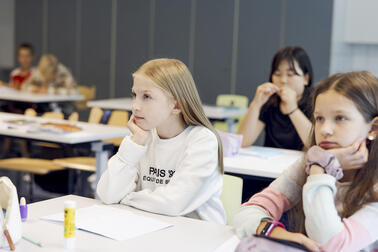
A statistical publication based on the results of the School Health Promotion study examines the well-being and health of children and young people in Helsinki. Children and young people participated in a survey conducted by the Finnish Institute for Health and Welfare in late spring 2021. At that time, a proportion of young people in Helsinki, especially in upper secondary schools, had been in distance learning due to restrictions related to the coronavirus epidemic.
A large proportion of children and young people in Helsinki are happy with their lives and feel that their health is good. Children and young people enjoy going to school or studying and have a good time at school. The majority have a weekly hobby. However, satisfaction with life, health and liking school or studies have declined in recent years. There have also been other worrying changes in the health and well-being of children and young people in recent years.
Challenging times for young people’s mental well-being
High or moderate symptoms of anxiety and depression have become even more common. One in three girls in grades 8 and 9 of comprehensive education experience anxiety or symptoms of depression. The rates are lower for boys, but they are still more common than in previous years. Almost one in four children in grades 4 and 5 of comprehensive education have experienced mood swings in the previous two weeks. Mental well-being challenges among Helsinki residents are generally more common than in the rest of the Helsinki Metropolitan Area and the country as a whole. Mental well-being was one of the main themes of the School Health Promotion study this year, so the publication covers the topic more comprehensively than before.
Loneliness among young people has increased – family life is more challenging than before
Loneliness experienced by young people has clearly increased in recent years. Around one in five young people experience loneliness frequently. Loneliness among children has remained at the same level of around 4% over the last few years.
Communication with parents has declined after a long period of positive development. Difficulties in communication have increased accordingly. The restrictions imposed by the coronavirus epidemic have also caused challenges to social relations, weakening interaction with people close to them in Helsinki more than in the rest of the country.
A higher proportion of children and young people have experienced parental emotional violence in the previous year. Depending on the age group, rates of parental emotional abuse range from 27% to 37%. Experiences of parental physical violence are also more common, ranging from 7% to 16% by age group. More than a third of young people have experienced sexual suggestion or harassment in the previous year. The experience of harassment is clearly more common among girls than boys and is more frequent than in the past.
Substance use is less frequent – sleep and meal patterns could be improved in some cases
There are some positive developments in health behaviour. The use of alcohol and tobacco products is less frequent among young people in Helsinki. Experimentation with cannabis and drugs has also decreased. Nevertheless, these experiments are more common in Helsinki than in the rest of the Helsinki Metropolitan Area or the country as a whole.
The proportion of children and young people engaging in an hour of daily physical activity has generally increased. Only students in vocational training are less likely than before to engage in an hour of daily physical activity. However, a higher proportion of both upper secondary school and vocational education students in Helsinki engage in an hour of daily physical activity than in the rest of the Helsinki Metropolitan Area or the country as a whole. Despite this positive trend, less than a fifth of students in secondary education and around a quarter of young people in grades 8 and 9 of comprehensive education engage in an hour of daily physical activity. A growing proportion of young people are also engaging in a maximum of one hour of weekly recreational exercise that causes them to become out of breath.
There are also some challenges in the rhythm of everyday life. A higher proportion of young people sleep less than eight hours a night. Internet causes challenges for some children and young people. More than a quarter of children miss breakfast at least one weekday morning a week. Skipping breakfast is more common among young people. Many also miss school meals at least once a week and do not eat all parts of school meals every day. However, students are satisfied with the quantity, quality and taste of school lunches, especially upper secondary schools. Food habits were another main theme of the School Health Promotion study this year, so the publication also looks at this issue in a broader context.
Students enjoy school, even though school fatigue is more common
One in four upper secondary school students experience school fatigue, a higher proportion than in the past. On the other hand, children and young people feel that they get on well with teachers and other schoolmates. A higher proportion feel that they are treated fairly and caringly by teachers. Almost all young people feel that they get help and support for their well-being, learning and school attendance from adults at school when they need it.
Enthusiastic response to the School Health Promotion study – some responded during distance learning
A total of around 23,800 children and young people at different levels of education in Helsinki responded to the School Health Promotion study conducted by the Finnish Institute for Health and Welfare (THL). Participants in the survey included pupils in the 4th–5th and 8th–9th grades of comprehensive education as well as students in the 1st and 2nd years of upper secondary and vocational education. For students in upper secondary education, the survey was aimed at students aged under 21 who had started their studies in 2019–2021: those studying the youth curriculum in upper secondary schools and those studying for a vocational upper secondary qualification in vocational schools. The results of the School Health Promotion study can be viewed openly on the THL results service(Link leads to external service) (in Finnish or Swedish language).
Municipalities in the Helsinki Metropolitan Area organise a School Health Promotion study webinar in November
The Helsinki Metropolitan Area municipalities of Helsinki, Espoo, Vantaa and Kauniainen, in cooperation with THL, are organising a webinar on the results of the School Health Promotion study and the well-being of children and young people in the Helsinki Metropolitan Area. The webinar will take place on Thursday 4 November from 12–15. The event is open to all and can be followed on the Helsinki-kanava channel(Link leads to external service) , where you can also find a more detailed programme of the webinar.
The Urban Research and Statistics Unit of the City of Helsinki carries out extensive urban research and manages the basic databases, statistical publications and information services for the City’s statistical activities.
Read more:
Kouluterveyskysely 2021 – katsaus lasten ja nuorten hyvinvointiin ja terveyteen Helsingissä (Suvi Määttä)
Tiivistelmä
The Finnish Institute for Health and Welfare(Link leads to external service) (THL)
The Helsinki-kanava channel(Link leads to external service)
The Urban Research and Statistics Unit at Helsinki City Executive Office
Image: Charlotte Forsgård © City of Helsinki.


